Books of Hours: a medieval hybrid of calendar and prayer book
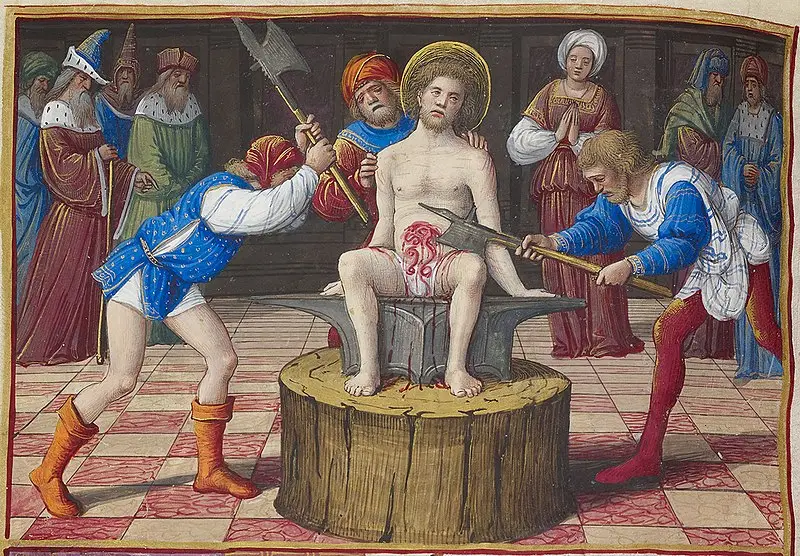
Jean Poyer "The Martyrdom of Saint Adrian" (fragment). Miniature from the Book of Hours of Henry VIII. Morgan Library and Museum, New York
whatever you ask for
in prayer, believe
what will you get -
and it will be to you.Gospel of Mark, 11:24
Literature of the Middle Ages. Our story about the literature of the Middle Ages will not be complete, of course, without mentioning such illuminated manuscripts of this time as books of hours. The Book of Hours is a Christian prayer book that was used to pray at the appropriate time, that is, by the hour. Hence its name.
In the Middle Ages, books of hours became a widespread form of literature, and their artistic design surpassed even many other books of that time. It is clear that, like any other manuscript, each handwritten book of hours is unique in its own way, although most of them contain a very similar set of religious texts and prayers. The design of many of them is purely utilitarian and is limited only to capital letters at the beginning of the texts.
However, books of hours are also known, commissioned by noble persons, decorated extremely luxuriously and containing miniatures the size of the entire page. The illustrations with which they were decorated depicted both picturesque scenes of rural life and images illustrating texts from the Bible.
Books of hours were usually written in Latin, but at the same time, many of them, especially the books of hours of the 15th century, could be written in whole or in part in the vernacular languages of a particular European country.
Tens of thousands of books of hours have survived to this day, that is, these books were extremely popular.

Miniature from the Book of Hours of Henry VIII. Same artist. "Annunciation"

November. “The Book of Hours of Henry VIII.” The margins of the book of hours depict saints whose memory is honored in November. Death in the form of a skeleton for All Souls' Day. And back in November, pigs grazed in oak forests, which dropped acorns just in November...
A typical book of hours is a condensed form of a church book that contains Divine services read in monasteries, but designed for lay people who wanted to get closer to monasticism in their worldly life, that is, to pray to the Lord strictly by the hour.
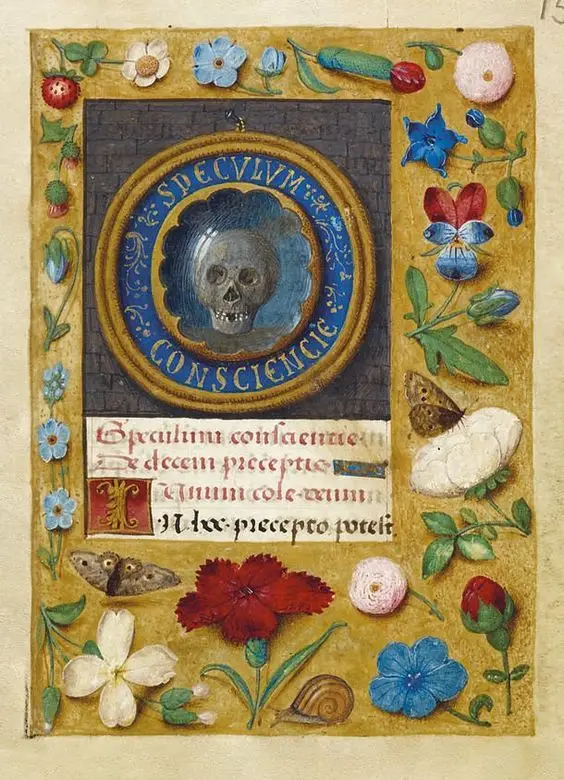
A skull in the mirror and butterflies fluttering around it. Miniature from the Book of Hours of Queen Juana the Mad (1486–1506). British Library
An ordinary book of hours contained a calendar of church holidays, excerpts from the four Gospels, the Little Service of the Blessed Virgin Mary, seven penitential psalms, a service for the dead, and much more. And at the same time, the pages of custom books of hours for the powers that be were always richly decorated with miniatures. The seasons and activities of each corresponding month, scenes from Scripture, decorative vignettes and screensavers were depicted.
Books of hours originate from a book like the Psalter, which monks and nuns had to constantly read and know by heart. By the 12th century, this book (which we will definitely talk about later) had become a breviary with a weekly schedule of psalms, prayers, hymns and readings that changed depending on the season. Over time, the selection of texts was trimmed down, presented to the laity in volumes much smaller than those of the monks, and began to be called the Book of Hours.
In the second half of the 13th century, books of hours became popular as personal prayer books for men and women of a secular lifestyle, but who did not forget about its spiritual component. Moreover, many books of hours were made for women. Sometimes they were specially ordered for a wedding and given as a wedding gift that the husband gave to his bride.
The value of such books was exceptionally great, so they were passed on by inheritance and recorded in inventories of escheated property and in wills. Until the 15th century, most books of hours were written on parchment made from animal skins, which further increased their price. At the same time, books of hours, simply designed and written on paper, became more and more accessible not only to the nobility, but also to the urban population.
Moreover, the earliest surviving English copy of such a book of hours was apparently written for a laywoman living in or near Oxford around 1240. It is smaller than a modern paperback pocket edition and features large initials, but does not contain page-sized miniatures.
By the 1500th century, even servants had their own books of hours. So, in a court case from XNUMX, one poor woman was accused of stealing such a book from... a domestic servant.
However, completely different manuscripts brought glory to medieval books of hours, for example, “The Book of Hours of Jean de Montauban,” prepared around 1430–1440. and located today in the city of Rennes, in the Rennes Metropole Library, the Museum of Brittany. It has 258 pages and 254 miniatures, of which 37 take up a full page.
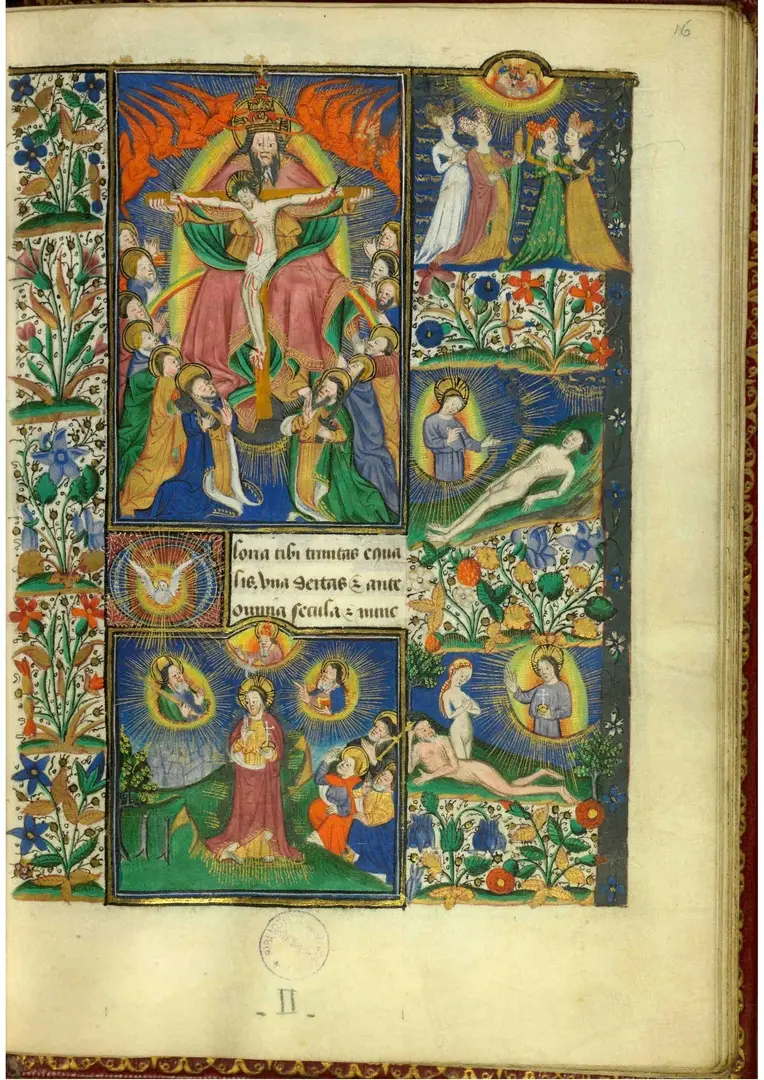
A page from the Book of Hours of Jean de Montauban, where you can see a lot of interesting things
Thus, in the upper right corner, in the eternity of God before the creation of the world, there is a debate about the four cardinal virtues (Prudence, Temperance, Fortitude and Justice, represented by women in high headdresses) on the occasion of the creation of the world and man. In this case, the discussion takes place in the presence of the “Trinity of the Psalms” (that is, God the Father and God the Son, sitting side by side, here facing each other, with the Dove between them, which is the Holy Spirit).
Below, in the lower right corner, is the creation of Adam, and the Lord is depicted with a cruciferous halo, without a beard and a very youthful appearance, similar to Christ’s. This is followed by the creation of Eve... At the same time, Adam seems to be awake and watches what is happening with curiosity, although he lies at full length on the ground.
Below left is the episode of the Transfiguration of Christ, told by the three evangelists (Matt. 17:1-9; Mark 9:2-9; Luke 9:28-36), and with the three apostles, Peter, James and John, as witnesses, in the lower right part of the miniature, while at the top there are two heavenly witnesses: Moses on the left and Elijah on the right. Christ stands in the center, and above him is God the Father, releasing the Dove of the Holy Spirit.
Finally, above, all twelve apostles kneel, and St. Peter on the left in front carries two keys on his shoulder, symbolizing his role as head of the apostolic college. To his right is the Apostle Paul with a sword. The Apostles majestically surround God the Father, who is crowned with a triple crown by two of the eight fiery angels gathered around and above him.
This triple crown, still called the "Trinity," first appeared in Western art around 1300 during the short pontificate of Boniface VIII. This symbol, reserved exclusively for the Pope, is an emblem of his triple power.
God sits on a rainbow, dressed in luxurious clothes, supporting with his outstretched arms the horizontal crossbar of the cross, which depicts the crucified Christ with three nails and blood flowing profusely. The Dove of the Holy Spirit forms the link between this Throne of Grace and the Transfiguration. And around all this there are whole thickets of a variety of flowers...

Original initials from the Book of Hours of Charles of Angoulême
The Book of Hours of Charles of Angoulême was commissioned by Charles of Orléans, Count of Angoulême and father of King Francis I of France, in 1482–1485. in Paris to Robin Testard and Jean Bourdichon. The manuscript consists of 230 leaves and contains 38 miniatures, including 7 large ones, as well as borders, initials, ornaments and margins. The text is Latin on parchment.
After Charles of Angoulême, this book of hours was owned by Jean Baldens, a Parisian lawyer and bibliophile; the manuscript then ended up in the collection of Jean-Baptiste Colbert and finally ended up in the National Library of France, where it remains today.

Christ awaiting crucifixion. "The Book of Hours of Charles of Angoulême"
The originality of this book of hours makes it one of the most unusual representatives of the family of books of hours. The introduction of elements of a secular nature, genre scenes, mythological or purely knightly into the book emphasizes its originality in comparison with the canonical examples of this category of manuscripts.

Carrying the cross. "The Book of Hours of Charles of Angoulême"
At the turn of the Middle Ages and the New Age, the Book of Hours of Henry VIII was created, illustrated by Jean Poyer in Tours. Its 400 pages contain 55 full-page miniatures. It is located at the Morgan Library and Museum in New York. Considered one of Jean Poyer's most famous works.
Incredibly expensive pigments Angelico Blue and Tyrian Purple were used to design the manuscript. Therefore, such a book could only be owned by an exceptionally rich and influential person of that time, which Henry VIII was.
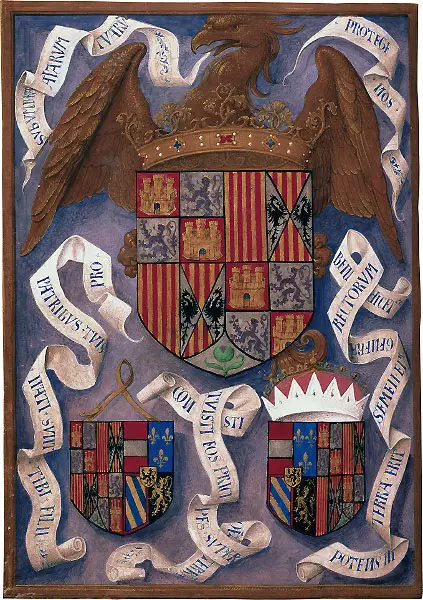
Queen Isabella I's breviary: coats of arms of the Catholic monarchs and the marriage coats of arms of her children
Breviary (essentially the same book of hours) of Queen Isabella of Castile. Illuminated manuscript from the late 1497th century, currently in the British Library, London. The Queen received the manuscript shortly before 523 from her ambassador Francisco de Rojas to commemorate the double marriage of her children and those of Emperor Maximilian of Austria and Duchess Mary of Burgundy. In total it contains 170 sheets and XNUMX miniatures. It is considered one of the most ornate breviaries to survive.
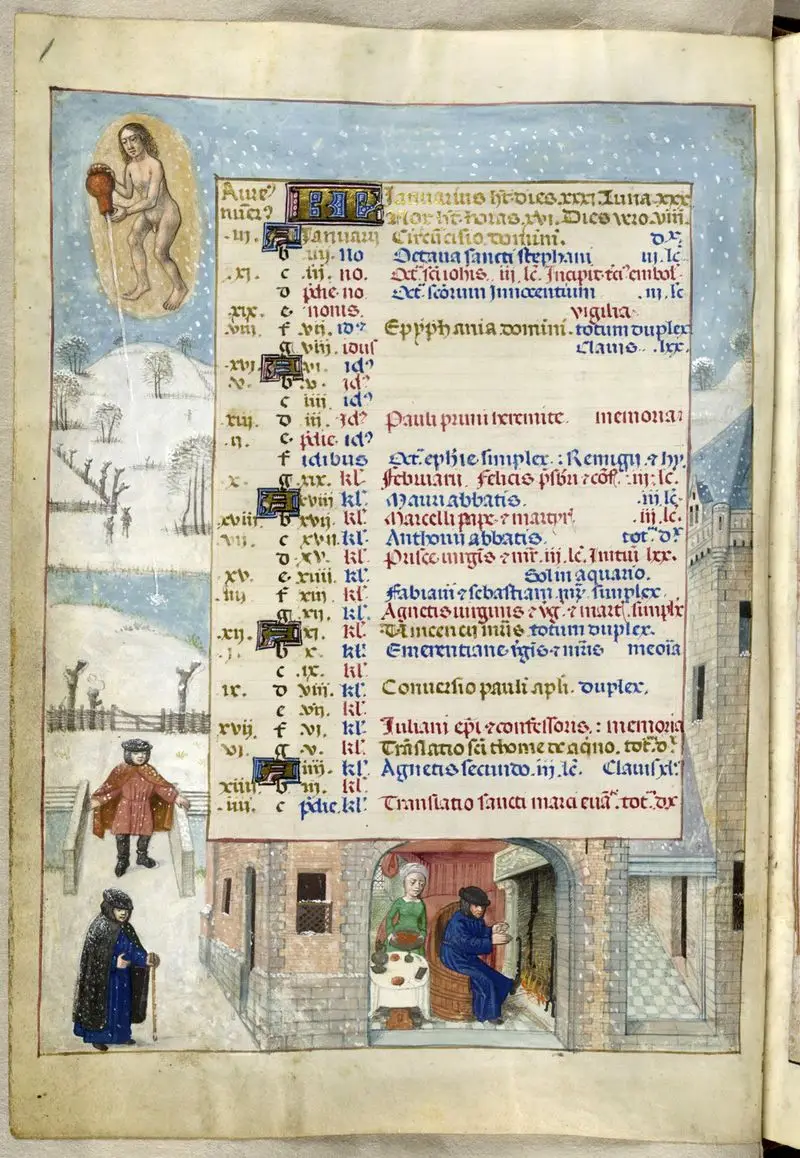
Breviary of Queen Isabella I. Calendar page - January. It is immediately obvious that it is very cold outside. Free Library of Philadelphia
The Book of Hours of Louis XII of France was created by the excellent illustrator Jean Bourdichon, but this manuscript was very unlucky. In 1700 it was torn into many fragments, so that today pages containing miniatures of it are in the Getty Museum (3), the Free Library of Philadelphia (4 calendar pages), the British Library (3, plus most pages of text), and one each in each: the National Library of Scotland, the Marmottan Museum in Paris, the Bristol City Museum and Art Gallery, the Victoria and Albert Museum, the Louvre and a private collection in London. All but one of the sheets were put together only in 2005 for an exhibition at the Getty Museum and the Victoria and Albert Museum.

Bathsheba's bath. Miniature from the Book of Hours of Louis XII of France. The miniature illustrates a moment from the Old Testament described in the Second Book of Samuel: King David sees Bathsheba bathing and, enchanted by her charms, enters into carnal relations with her. Well, in order to marry Bathsheba and thereby cover up his sin, he sends her husband Uriah to war, ordering his military leaders to throw him to certain death. Getty Museum
A completely unique phenomenon for the Middle Ages are the so-called “Black Books of Hours,” which got their name from the color of their pages. One of the few surviving handwritten books with black pages was created around 1475 in Bruges by an artist close to Willem Vrelant. It was probably made by order of one of the courtiers of the Duke of Burgundy. Currently located at the Morgan Library and Museum in New York.

The Black Book of Hours from Bruges is one of seven surviving manuscripts whose pages were colored through a complex process using soot or solutions of copper and iron compounds. All known manuscripts with black pages come from Flemish workshops and date back to the second half of the 15th century
The Black Book of Hours from Bruges has 121 text leaves, 14 full-page miniatures, 15 large and many small initials, and 138 decorative borders. The text is made in gold and silver ink, the background of the initials is emerald green. Gold leaf and white lead were used to illuminate the manuscript. The borders are painted in gold on a blue background.
The black background of the pages favorably emphasizes the generally very limited color range of the artwork. At the same time, the bright decor on a black background clearly creates a feeling of something scary, some kind of threat...
Interestingly, the book is quite well preserved, although the black paint is peeling in some places.
The author is an anonymous miniaturist of the “Black Book of Hours”, whose style clearly indicates that he was part of the circle of Willem Vrelant, one of the leading masters of book miniatures who worked in Bruges, remained nameless for us, but received the name “Master of the Black Book of Hours”. Nothing is known about other manuscripts made by this master.
For whom the “Black Book of Hours” was made is also unknown. The book does not contain an image of the coat of arms of its owner, and one can only assume that the customer of the manuscript could have been one of the courtiers of Duke Charles the Bold. There are six more similar books of hours, in particular the “Black Book of Hours of Charles the Bold” (Austrian National Library, Vienna) and the “Book of Hours of Mary of Burgundy,” which is stored in the same library.
Well, what is the most famous book of hours today?
There can’t even be two opinions here. Well, of course, “The Magnificent Book of Hours of the Duke of Berry” or “The Luxurious Book of Hours of the Duke of Berry”, world-famous for his cycle of illustrations “The Seasons”, which consists of 12 miniatures depicting the entertainment of the nobility or peasant work against the backdrop of medieval castles.
Duke Jean of Berry ordered it from the miniaturist brothers Paul, Jean and Hermann Limburg in 1410–1411, and the manuscript remained unfinished due to the death of all three artists and the customer himself in 1416. The calendar part was added to it by an anonymous artist in the 1440s and 1450s. Then, in 1485–1486, by order of Charles I of Savoy, the artist Jean Colomb worked on it, but some of his sheets remained unfinished.
The manuscript is kept in the Chateau de Chantilly (Museum of Condé), since, according to the will of its late owner, who handed it over to the state, it should never leave its borders. The book of hours contains 206 sheets (412 pages), which are grouped into five parts, 66 of them have full-page illustrations, 65 are small-sized miniatures.
They contain information, well, simply... a sea.
Here, for example, is an illustration of the exchange of gifts at the court of the Duke of Berry during the New Year. The Duke himself sits at the head of the table, dressed in blue. In the crowd of guests, the Limburgs are believed to have depicted themselves (two in red turbans and one in white in front of them). A small dog walks around the table and apparently plays the role of a walking napkin. The tympanum of the miniature (its upper part) depicts the constellations Capricorn and Aquarius.
However, there is an opinion that this miniature depicts something completely different. Not a celebration of the New Year, but a feast on the occasion of the completion of negotiations with the British at the castle of Giac on January 6, 1414, which were carried out by the Duke of Berry.

Miniature “January” or “New Year’s Eve at the Duke of Berry”

Miniature “February”. "The Magnificent Book of Hours of the Duke of Berry." Interestingly, at first glance, winter seems quite snowy and cold...
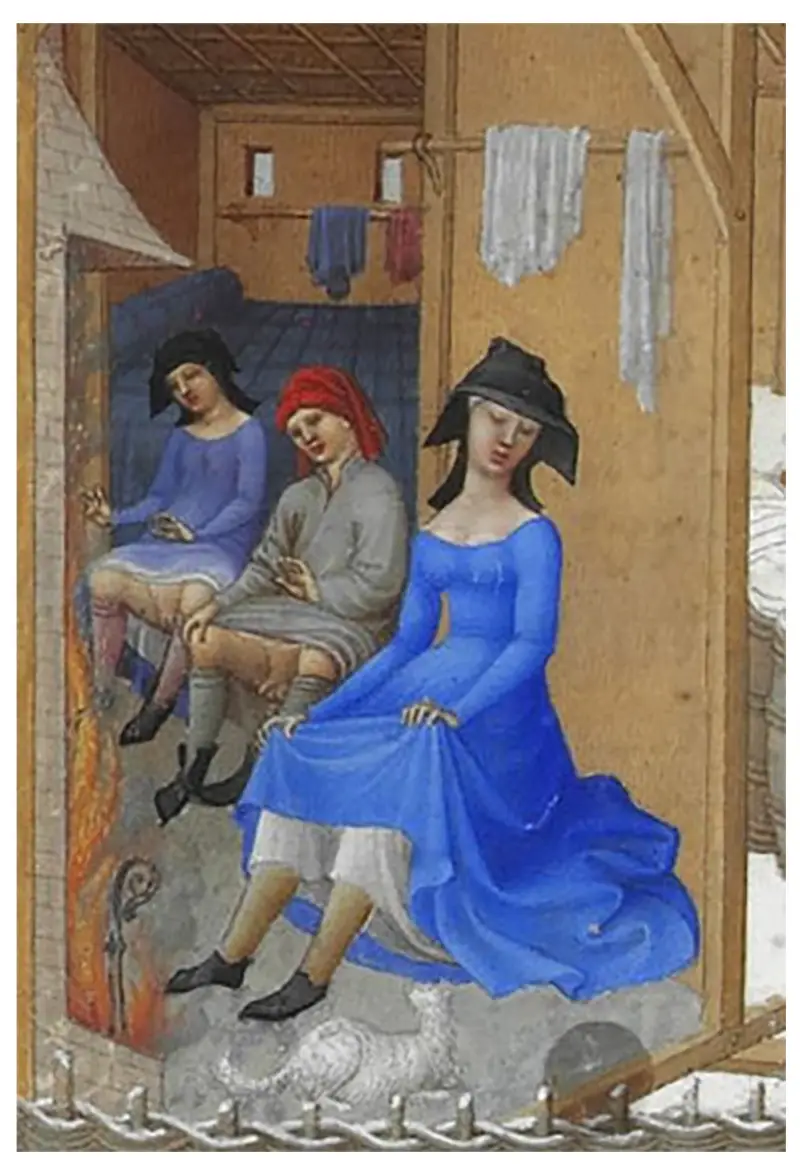
But in this enlarged fragment of this miniature it is very clearly visible that for some reason the artists did not draw underwear on the two participants in this scene. We see that all three of them are warming themselves near a blazing fireplace (along with a cat), but for some reason two characters - a boy and a girl - have nothing under their outerwear? Really, having such a household, were they so poor that they could not even afford this?
Information